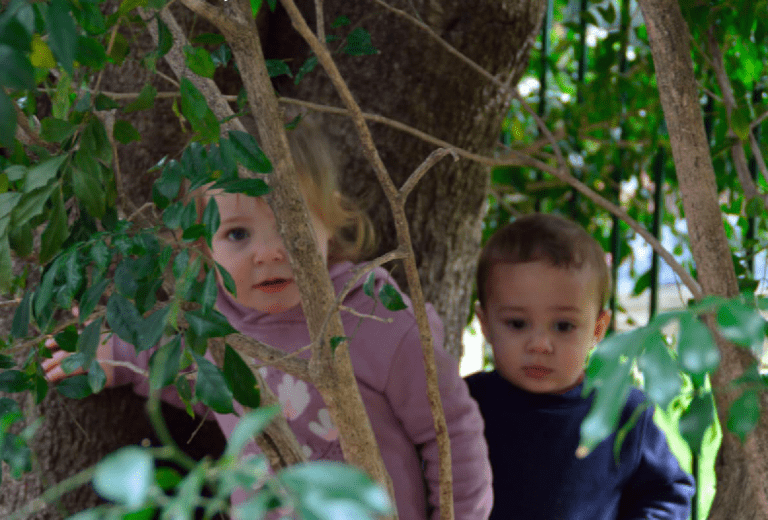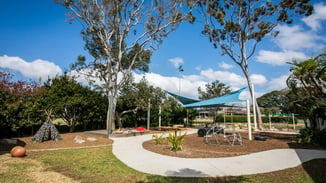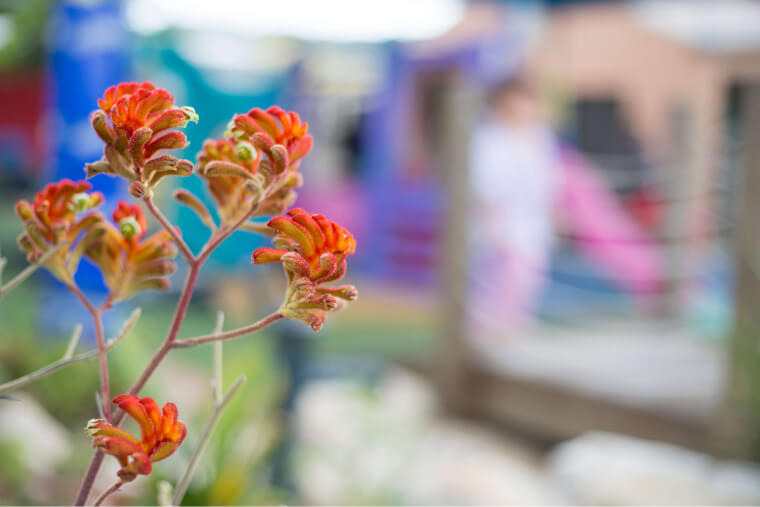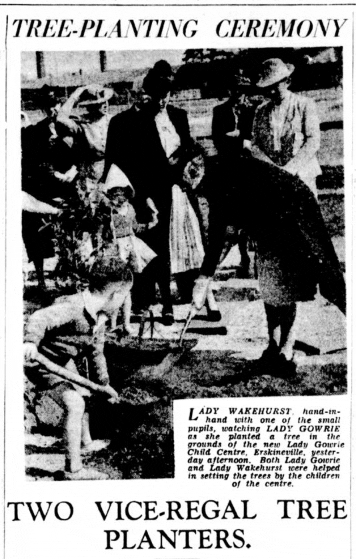An Educator’s Reflections about space and place at Gowrie NSW Erskineville Early Education and Care
By Jessica Horne-Kennedy
“Spaces speak to our emotions and it is through our memories, imaginings, hopes and dreams that these spaces are transformed into significant places – holding rich meaning.”
(Greenman,1998, p.16-17).
The way a space transforms from simply a space we inhabit to a place of meaning and significance happens through the kinds of experiences we have in that space – each being significant and unique to who we are as a person. In a last letter to her close friend Ida Barker, the poetic words of New Zealand author Katherine Mansfield describe how our connection to spaces impact on our experience throughout life.
“How hard it is to escape from places. However carefully one goes they hold you – you leave little bits of yourself fluttering on the fences – little rags and shreds of your very life.”
(Mansfield, 1922 cited in Greenman, 1998).

Considering this literature about the language of spaces prompted my reflection about what makes a learning space significant. I began to wonder – How does the physical make-up and design of a space speak to educators, children, families and visitors? This interest in the theory underpinning learning environments has led me to consider how the spaces I regularly interact in become places of significance. One space I have interest in is the learning environment at Gowrie NSW Erskineville, Early Education and Care Centre. ‘Gowrie Erskineville’ has been part of the local community since it opened in 1940 and I have had a connection to this environment since 2011 when I moved to Sydney from New Zealand.
The first time I walked through the gates of ‘Gowrie Erskineville’ I was with my daughter and we were exploring options for early childhood education in the community. On this visit, I remember noticing the traces of history that were evident in the physical environment of the centre. The traces that captured my attention were things like the foundation stone set into the entrance pathway, the large windows and their wooden frames as well as the established trees in the outside play spaces. Seeing the richness of history embedded in the physical qualities of this space initiated a wondering process. I wanted to know: what was this place like before? What is this place like now? And, so my journey with Gowrie NSW began. Since that first encounter, my relationship to this space has changed from being a parent to now being a member of the organisation. I have spent more time at Gowrie Erskineville and have seen this space adapt and change.
 In their paper ‘Creating Children’s Spaces, Children Co-Creating Place’, Nicole Green and Michelle Turner draw from the work of Cultural Geographers who use the term ‘sense of place’ to refer to an individual and personal connections we have with place. With this focus, the idea that “place is continually and dynamically formed from, and out of, the process of spending time in it.” suggests that over time spaces also become part of us (2017, p.28).
In their paper ‘Creating Children’s Spaces, Children Co-Creating Place’, Nicole Green and Michelle Turner draw from the work of Cultural Geographers who use the term ‘sense of place’ to refer to an individual and personal connections we have with place. With this focus, the idea that “place is continually and dynamically formed from, and out of, the process of spending time in it.” suggests that over time spaces also become part of us (2017, p.28).
Cultural geographers ask: “What is the meaning of place, and how is human identity structured through place?” (Green & Turner, 2017, p.36).
My curiosity about the historical narratives embedded within the environment at ‘Gowrie Erskineville’ has prompted me to ask more questions about what enables a space to be a holder of significant meaning to positively impact children’s play and learning. I have wanted to compare and contrast my experiences with those of other early childhood educators who work in these spaces on a daily basis. Therefore, my primary reason for holding a series of open-ended conversational interviews was to gain insight into educators’ connections to the historical elements of the learning environment. I was also curious to understand how the historical element including the recent renovation at this service (which has brought this element of history into focus) has influenced the children’s play and experiences.
My first questions were:
- What were your first impressions of this place – do you have special memories?
- What do you remember about the environment especially the elements of history in the space
- What are the elements of the space that make you wonder about the history – for example who walked and worked in these spaces in the past?
- How do you think that the design of the space ‘speaks’ to educators, children, families and visitors?
Two things happened during this research process. Firstly, as Punch (2009) suggests, each interview became a powerful way to understand how each educator perceived the element of history contained within the space. Their perception was based on their memory and experiences of working in the space. The second surprising, but important element was the way my role changed from being ‘the interviewer’ to that of participant researcher. O’Hara -Gregan (2015) describes how a researcher’s own stories and perceptions can be shared with the participants, meaning that the researcher is in the picture with the participants and the researcher’s own narrative is woven into the research process.

Similarly, in ‘Capturing the Story, an Exploration of Respectful Documentation, I commented on how the early stages of a narrative enquiry are like “…threads in a woven cloth – unravelling, interconnecting and merging” (Horne-Kennedy, 2018, p.4). Through my initial conversations with educators at Gowrie Erskineville, I have begun to weave together a series of short narratives to express what educators perceive as being the meaningful aspects of the learning spaces they work in. The stories are an entry point to understanding how the lived experiences and memories of each educator offer a unique and significant contribution to the history of this evolving learning environment.
First threads. A sense of calm and the significance of trees
The first ‘threads’ that surfaced, as the educators reflected during our conversations, were descriptions about the trees at Gowrie Erskineville and the influence of nature on the children’s play and wellbeing.
For many of the educators, a first memory of working in this environment was a strong sense of calmness that was felt when they began working at Gowrie NSW Erskineville.
Fahmida began this story by telling me that her earliest memories of this learning space are ones where the atmosphere is “nice and calm”. For Dalia, this picture of calmness is connected to mindfulness practice which allows her to be present in her interactions with the children:
“Having a natural environment around you, gives you this peace of mind where you can take yourself and the children around for a quick walk – calm down a little bit – a few minutes of mindfulness. Like listening to the sound of the trees when the branches move around, (or) to the birds when they fly around. Even watching the spiders crawling on the tree – it’s a very calm time when you can just listen to the children while they are talking about what the spider is doing or asking questions like: how far will it go? Things like that – even the young age-group, when they touch the trees, they just take some time to look at the tree and feel it in their fingers, it’s important to just give them that time – where they can focus on just one thing instead of getting busy with everything around. I think that is more sensory – where you can just use your eyes, hands or ears. That’s the main thing about calmness in that place.”
Hinh also told me that the space is “…nice because we have a big tree – the Jacaranda. The Jacaranda …flowers fall down, and the babies love it …its very relaxed and calm. The Jacaranda soothes the babies to sleep … sometimes the babies cannot settle to sleep so we take the babies outside to rest under the Jacaranda tree”.
The Jacaranda tree is important and another educator shared joyful memories of how children she has taught have played. Children notice the tree and play with its treasures in unique ways. Rasaluxmy explained that “In the flowering time, children pick up the flowers and gather them in a basket, like they are at a wedding. The children have a special connection to the Jacaranda. They often can be observed “…picking up the flowers and using the leaves …. they are using the tree as a resource”.
Another way of connecting with this tree is through “…the leaves, the middle part (the short branches). The children collect that part and they tie it together and then they are ‘cleaning’. It’s like they have made a little broom”.
Other educators also shared the diverse ways they have seen children engaged with the environment during play. Yan shared that the children love “…the trees and some children collect the sticks and put them down as a tool for counting. They also love to use the leaves just like cooking ingredients for their teddy.”
The trees are the history of this space
“The fact that the tree is old, but it has some spaces in it…where children go into their fantasy/ imagination world… we have children coming back (when they are older) and telling us stories from when they were young, about what they were playing then. The children played dragons, and we wrote a whole story – a project related to dragons – related to the tree. It is a very significant tree…the gardens in the infants’ space have been here for a long long time and I remember when it’s really really hot we used to bring the children and they would have a little rest or nap under the tree. Still the children go into the tree and they make up their play…it gives them their own space …so they want to be just with their friends and just doing something in their own little spot….”
(Zarina)

In final conversation with Anti, the centre’s outdoor teacher, I was provided with an important analogy of how the past and present are in relationship to each other.
Through this awareness, a ‘new state’ becomes apparent. Anti is facilitating a project of “…rearranging the play spaces with plants (to) rearrange the spaces with the children.” The intention is to make more definition …to create small intimate spaces …and the way that we are going to do it is with propagating – that’s another thing of taking and then giving back with children…” The spaces are being transformed into something new, where the past is contained within the present. The past is necessary for these new spaces to emerge.
A moment to pause
As I listened to the stories of these educators, I uncovered the ways that the physical spaces at Gowrie Erskineville ‘speak’ to educators and children.
This discussion is seen as being a starting point in an ongoing narrative but for now, Daniel Stern’s reference to the Greek word Kairos can perhaps point to what is happening as we take a moment to pause and consolidate the thoughts that have been shared through this inquiry process.
“Kairos is the passing moment in which something happens as the time unfolds. It is the coming into being of a new state of things and it happens in a moment of awareness. It has its own boundaries and escapes or transcends the passage of linear time. Yet, it also contains a past”
(Stern, 2003, p.2).
The opportunities for children to form deep connections to place and the natural world through connections with nature become the basis for “…understanding the world and living sustainably in it” (Ward, 2019, p. 617). Through the connections to the past -articulated through each educator’s descriptions of nature in the learning space – Gowrie’s rich natural heritage is being carried into the present for today to make a memory for the future.
Acknowledgement
Acknowledgement and thanks to the educators from Gowrie NSW Erskineville Early Education and Care who shared their time and thoughts for this article: Eleni Kabitsi, Fahmida Akhter, Zarina Khan, Hinh Le, Raji Alagendran, Yan Zhuang, Anti Stopic and Dalia Benjamin.
Reference List
Jim Greenman, J. (1988). Caring Spaces, Learning Places: Children’s Environments That Work. Redmond: Exchange Press.
Green, M. & Turner, M. (2017). Creating Children’s Spaces, Children Co-Creating Place. Journal of Childhood Studies. 42 (3), 27-39.
Punch, K., F. (2009). Introduction to Research Methods in Education. London: SAGE.
Horne-Kennedy, J. (2018). Capturing the Story, an Exploration of Respectful Documentation
Reflections, Gowrie Australia. Retrieved from: https:// www.gowriensw.com.au/images/Reflections/ Reflections-2018-6.pdf
O’Hara – Gregan, J. (2015). Being honest, real and true to yourself: Stories of authenticity in early childhood teaching. The First Years Ngā Tau Tuatahi. 17 (1), 22-28.
Stern, D. (2003). The Present Moment. Psychotherapy Networker. 27 (6), 1-7.
Ward, K. (2019). Singing in the Forest: Outdoor Education as Early Childhood Curriculum. In: T. Gray,
D. Mitten (Eds.), The Palgrave International Handbook of Women and Outdoor Learning, Palgrave Studies in Gender and Education. (pp. 607-621). Retrieved from: https://link.springer.com/chapter/10.1007%2F978-3-319-53550-0_41
THIS ARTICLE FIRST APPEARED IN REFLECTIONS, OCTOBER 2019.




